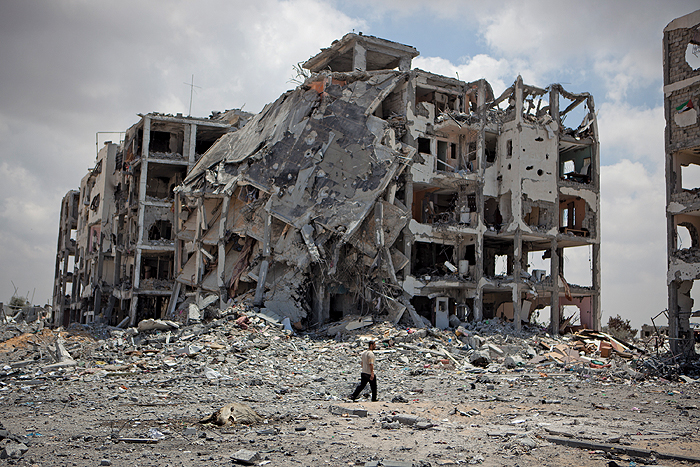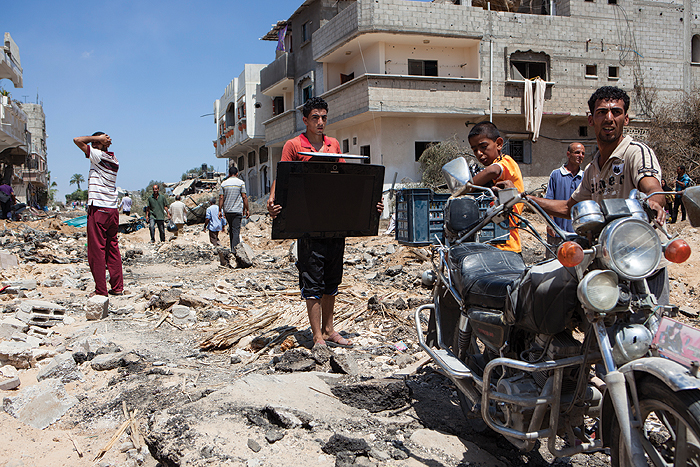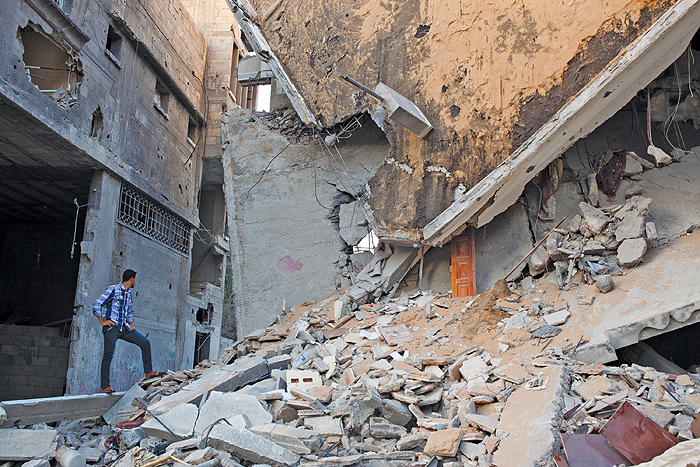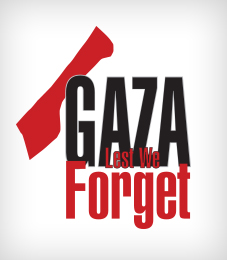
Over a period of four decades, Copenhagen has been transformed from an insignificant urban space with unsatisfied inhabitants into the world’s happiest city in 2013. The Danish planner Jan Gehl – who accompanied and contributed to this rebirth – emphasised the role of “self-reinforcement” of both positive and negative socio-spatial trends, and therein the accumulative impact on the lived space. As the tribulation of the Gaza Strip by Zionist colonialism has become a reiterative prophecy, it is essential to address the stagnant trivial questions: Reconstruction of what? How and to what end beyond the obvious physical? Is today different from yesterday? Will tomorrow diverge from the reincarnations of modern history? Haven’t we – Palestinians – been building makeshift-shelters for years aplenty? Will we break off the engagement with the “déjà vu!” expression? When will we obstruct the harmony conjoining the Zionist strategy of spatial annihilation and our reactionary discourse, which together reinforce the precariousness of Palestinian existence? Although declaring and echoing statistics of human casualties and material losses, and employing those as indicators of a rise in scale and intensity of Israeli aggression against Palestinians are relatively apparent, comprehension of roots and real-time consequences is more complex.
More than 2,000 lives have been lost over the past few weeks, and according to UN estimates this tragedy is furthered by the displacement of over 500,000 persons. In other words, about 1 of every 3 persons in the Gaza Strip has been made a refugee, some for the second, and others for the third time in a lifetime. A Facebook post by Mohamad Joudeh from Gaza was shared by a couple of my contacts:
“I’ll tell you what is harder than dying in Gaza by an Israeli missile deluxe. What is harder is that you get a phone call from the Israeli army telling you to evacuate your home because it will be bombed in ten minutes. Imagine. Ten minutes; and your whole short history on the surface of the earth will be erased. […] things that you love, your favourite chair, your books, that last poetry collection you read, a letter from your expatriate sister […] your prayer rug, your wife’s gold, your savings. Imagine. All this passes in front of your eyes in ten minutes; all that pain passes while you are struck by surprise. Then you take your identification papers (passport, birth certificate, etc.) which you have ready in an old metallic candy box, and you leave your home to die a thousand times, or refuse to leave and die once.”
In his book The Prince (written ca. 1505), the Florentine political philosopher Niccolò Machiavelli wrote that “men forget more easily the death of their father than the loss of their patrimony.” He argued that destruction of life, i.e., murdering individuals, could aid in upholding societal order as it instils fear yet does not amount to systematic – hence unforgettable and unforgivable – suffering. However, destruction of livelihood (e.g., source of income, accumulated wealth, securities, etc.) and hence infliction of long-term systematically regenerated suffering breeds desperation, and perpetuates desires of vengeance and the mentality of crisis, amongst others. The genocide in the Gaza Strip today and in the entire geography of Palestine since 1947 is not comparable to Machiavellian cases of “arguable” state prosecution of individual subjects. However, deprivation of Palestinians from elements of dignified life and modernity through spatial – hence social, economic, and ideological – annihilation has been quintessential to the colonial discourse, as transcribed by Machiavelli centuries ago and expounded in countless volumes of works since; from acts of Zionist militia-terrorism to State of Israel mayhem, from Deir Yassin to Shuja’iyya.
Israel justified and continues to justify its destruction of homes, neighbourhoods, and communities for reasons of “security,” using bulldozers, segregation walls, tightened economic valves, and advanced weaponry. These highly expensive operations of intensive and extended, direct and indirect sustenance of Palestinian emergency are an existential requirement for the continuation of its colonial superiority; therein maintaining a Palestinian inferiority and impeding the re-emergence of a societal modernity capable of leading a successful revolution. While the erasure of over 400 villages and the confiscation of land throughout and after the Nakba is often displayed, the hijacking of the major Palestinian urban centres of modernity is underplayed. Subsidiarity is not only financial or legal, as often discussed, but ultimately and more importantly, intellectual and therein societal. Economic dependency – e.g., through destruction – is predominantly a tool for ideological co-optation which in this case is two-fold: first, enabling self-imposed socio-economic shackling through perpetuation (self-reinforcement) of non-individuality, and second, political castration.

Regarding the first, through citing history academia has shown that modernity and civic freedom, as well as decolonisation, require flexible, locational, and relational solidarities whose emergence is highly linked to alternative economies and societal practices, and therein the ability to choose beyond limited norms. Akin to other earthly processes, these require incubation and nurturing, hence partnerships, trust, and inspiring examples of fruition. Why would an inventor undertake the risks of start-up investment under conditions of blockade and periodic obliteration? How will new solidarities – hence ideas and practices – emerge under repeated displacement and societal amputation? The periodic Israeli spatial annihilation of Palestinian communities has little to do with security and a lot to do with impeding organic – and quintessential – social development in favour of hegemonic (and even fascist) socio-political systems.
Second, and in line with the former, over the past few decades the Palestinian liberation discourse has shifted from core principles of equality and dignified living conditions to being largely a reaction (a sort of inverse) to the Zionist rhetoric. It prioritises concepts of state monopoly over violence, thus reinforcing certain limited concepts of security as essential to self-determination rather than the opposite. In addition, it employs exclusive self-defining terminology such as “national genus” in the Palestinian Declaration of Independence of 1988; mirroring the Zionist mythology of the “Jewish People” in place of the genealogically evident ethnic and cultural diversity of Palestinians, e.g., wedding customs in the Galilee are closer to those in Lebanon than to those in Hebron, and although Palestinians are predominantly Muslim, burial traditions (tomb, biographical headstones, and visits on mornings of religious feasts) are closer to those of Christianity than to those in the birthplace of the prophet Mohammad, in Saudi Arabia. Further, and while holding slogans of planned state-building, destruction is utilised to enable colonial spatial re-organisation and social re-grouping, one prioritising military surveillance possibilities and control over societal needs as seen in the reconstruction designs of the Jenin Refugee Camp after the urbicide inflicted by Israel in its 2002 Operation Defensive Shield.

Questioning the reactive “reconstruction” imaginations projected in the media and commencing discussions over potential organic, innovative, and visionary initiatives is paramount for Gaza, in particular, and for the entire geography of Palestine, in general. The Zionist strategies of artificially induced emergency, cultivation of crude makeshift spaces as a mode of sustaining colonial superiority, and systematic impeding of socio-economic development of the colonised subjects through spatial alienation and annihilation are partially enabled by the current Palestinian political and institutional approaches, which are antithetic and ecologically non-viable. Unlike many experts with manuals, I do not claim knowledge of golden solutions for breaking either the state of “emergency” or mutated mentalities of “underdevelopment.” However, former Palestinian and regional experiences warn that regardless of the institution – whether UNRWA, Palestinian Authority, or neoliberal-private actors – a developer-based mass-reconstruction in Gaza will engrave the tragedy rather than set those aggrieved on the long tracks of rehabilitation. How true will the prophecy of Mohamad Joudeh of “dying a thousand times” turn out? And how can we impede the self-reinforcing processes of social de-development in face of the rising political neo-religiosity?
» Natasha Aruri is a Palestinian urbanist, architect, and planner who studied in Palestine, Germany, and Spain She is currently based in Berlin as a doctoral researcher of socio-spatial (de-)colonisation. She can be reached at: n.aruri@me.com.


